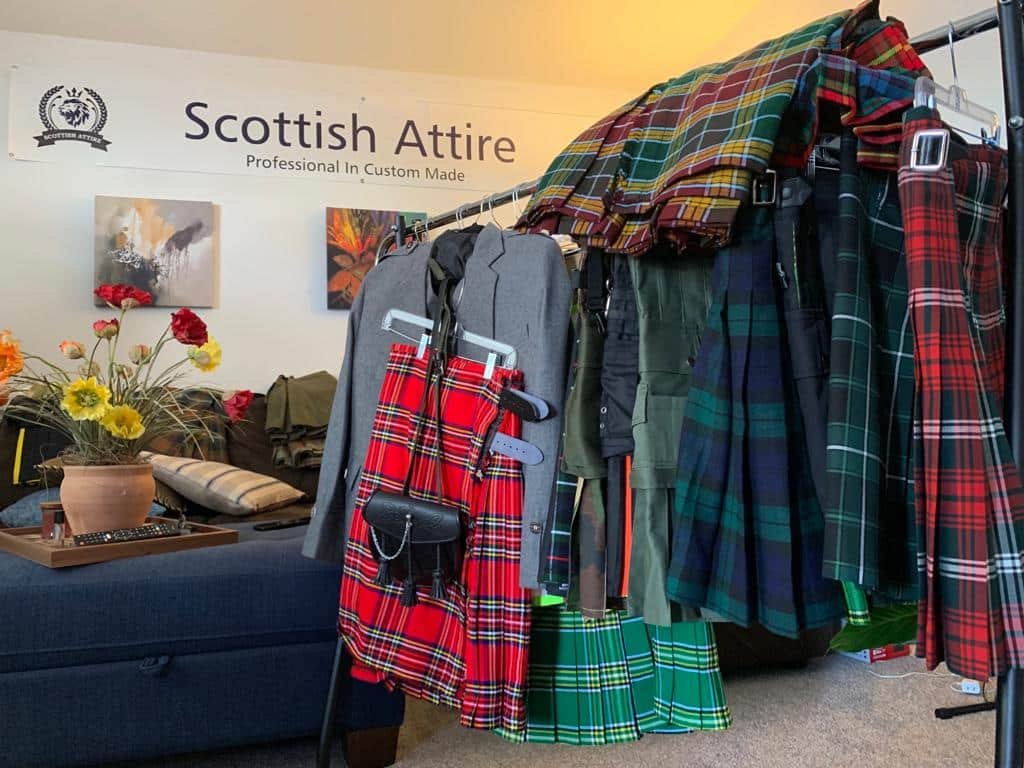How to make a Scottish Kilt or Dancer Kilt? Six easy Steps

Everyone loves kilts, right? This beautiful garment is much more than just a simple item of apparel. If you enjoy wearing kilts, you know how challenging it can be to locate the proper size. You can now make it at home, so there’s no need to worry. You will discover how to build a Scottish kilt in this post. In simple terms, a kilt is a wrapped, pleated skirt. The kilt’s front (apron) consists of two overlapping panels, while the rear is pleated. A genuine kilt is totally handcrafted.
In Scottish Attire version, we’ve made a few minor adjustments for wearability, such as adding Velcro to the front of the apron. The phrase “The Whole Nine Yards” derives from the fact that a large man’s kilt is constructed using a tartan fabric that is nine yards long. High-quality plaid yields two yards of kilt fabric and costs $55 per yard, 60 inches wide. Please visit our Kilt online shop.
Here are some easy steps for making a kilt at home if you want to avoid wearing a sewn kilt:
Scottish Kilt Material: Tartan Kilt Fabric
Choosing the base fabric for a kilt is the first stage in the process. Tartan, a semi-woolen fabric with a check pattern, is used to make kilts. A tartan represents every clan. The custom has persisted since the early 1800s. Even today, if your family has historical ties to a certain organization, you should prefer using that Tartan when constructing your kilt rather than sticking with the traditional Tartan pattern.
A single pleat consists of a whole set (pattern) width and an exposed pleat that is typically one inch wide. The pleating can be done “to the sett,” “to the pattern,” or “to the stripe,” according to the regiment. One pleat would require 9 inches if the set were 8 inches in size. For a 42-inch hip size, 4 yards of double-width tartan are needed.
- 21 inches of apron x 2 42 inches.
- 21 inches of pleating x 9 inches (8 inch sett + 1 inch exposed pleat) 189 inches. Total 231 inches.
- Add 20% for additional pleating and centering the apron pattern. 46 inches. Total Inches needed 277 inches.
- Divide by 72 (36×2 double width) 3.86 yards – rounds to 4 yards.
A smaller sett requires less material. 3.15 yards would be comparable to a 6-inch set. Just over 5 yards of 8-inch sett tartan would be needed for a larger guy with hip or waist measurements of 56 inches. A 6-inch set or smaller would be ideal for a child’s or dancer’s kilt, keeping the pattern in proportion to the wearer’s size. Two to two and a half yards of tartan would be sufficient to make a kilt for a youngster with a waist measurement of 26 inches and a 6-inch sett.
How to make a great Kilt Measurement? Lifetime Investment
It is yet another important factor. Measure the circumference of the hips and waist with the measuring tape. It will determine how much fabric is required. Women should start measuring from the narrowest portion of the waist to the widest part of the hips, while men should start measuring from the top of the buttocks or the most expansive section of the butts.
The quantity of pleating is determined by measuring the hips and waist. If a wide kilt belt is to be used, the length of the kilt should be measured from the waist to mid-knee, with an additional 2 inches for a higher rise (waist).
A helpful hint: Cut 1 yard of strong duck fabric into 10-inch widths to prepare the lining. Stopping at the side seams of the individual’s clothing, wrap one section around the back of the fit person. Sew it apart at the left and right side seams and wrap it around the front until it meets the opposing seam. Secure the ends of the apron portions with safety pins to assemble these parts. Now that the liner is specifically fitted, you can utilize it. You can fit the aprons and pleats to this lining as you create the kilt. The way the back piece is attached to the apron parts makes it simple to spot any changes in waist size relative to hip size.
Material for Tartan Kilt
Genuine tartan fabric has a completed selvage edge, which is utilized for the kilt’s bottom (hem). If the fabric doesn’t already have a finished edge, you should begin by hemming it at both the top and bottom edges, being sure to stitch in the same spot on both sides so that the pattern and depth of the hems match when you sew them together (end to end).
Cut the fabric into two pieces wide enough to span the distance between the waist and the hem. This will leave a lengthy middle strip that will serve as the waistline in part. The two pieces with wide hems should be stitched together following the sett’s pattern. Finish the fabric’s top edge with a serger, zigzag stitch, or anti-fraying liquid like Fray Stop or Fray Check.
Marking the Apron and Pleating the Kilt
The right side of the outer kilt apron will buckle. The tartan’s pattern needs to be correctly centered. Make a deep, double-width pleat on the left after folding the top down by at least 6 inches. Place a safety pin at the hip measurement to secure.
Continue to safety pin at the hip while making single-width pleats (see Pleating the Kilt below). At the opposite end of the pleating, pin in a broad, double-sett width box pleat. Next, pin back the end of the inside apron after measuring it to match the outside apron.
Imagine a deck of cards that has been spread out. Only a tiny portion of each card is visible due to the overlap of many cards. Each card’s hidden portion represents eight inches of fabric that have been doubled for the pleat. About 5/8 to 1 inch would be the exposed portion. Mark a cardboard piece with a set width. Divide the sett pattern into equal pieces. The easiest way to separate a portion of two wide color strips with a narrow stripe in the middle into three sections is to center the strip in the middle area. You can divide an 8-inch set into eight or more portions. You can use this piece of cardboard as a measurement tool as you pleat.
The edge of the pleat is placed over the subsequent sett’s complementary design to replicate the tartan’s pattern. At the hip level, secure each pleat with a safety pin. Once the necessary width has been reached, keep pleating.
Waist adjustment and Stitching Pleats
Darts can be pinned at the sides of the apron pieces to keep the first and last pleats straight on the grain. Doing so will adjust the apron for one of the waist/hip differences. Use safety pins to evenly distribute the other half of the difference between the pleats. To ensure a straight stitch, temporarily indicate the pleat adjustment angles where necessary.
Do two rows of basting between 1/4 and 1/2 up from the fabric’s bottom edge. A running stitch that catches the edge of each pleat can be used. This will also make steam pressing and sewing with the material easier, as well as making it more compact. Beginning at the bottom (hip point) of the pleat, sew blindly (fellingly). Fasten the thread two stitches from the bottom up, beneath three threads of the bottom material, and straight up to the top material of the pleat.
This should be done 12 inches from the reverse edge of the pleat. The needle is lowered to the bottom after passing through the top material approximately three times. The stitch density is approximately 10 per inch. Trim extra fabric from the waist to 1 inch above the hipline on the inside of the kilt at the top of each pleat. This strip would be 1 1/2 and 2 inches deep, removing most of the inside material.
Fringe, Waistband and Lining
Cut a piece of material 3 inches wide and the kilt’s length. To give the fringe a double thickness, fold this piece in half. This will be sewn into the right side of the apron’s doubled (Z-shaped) edge. Pulling out the vertical threads, you can fringe this after it has been put in place.
For the waistline, trim a 5-inch broad strip. We are commencing at the outermost apron’s first edge, matching the fabric’s design. Turn the waistband strip’s bottom edge under. Blind (felling) stitch 1 to 1 12 inches from the top edge of the apron at a distance of 1/2 inch. Overlap the kilt’s top with the leftover width. This side won’t be seen because the liner will conceal it. By using an overlapping stitch along the top and inside apron side and tacking the bottom edge of the middle part to the rear of the pleats, sew the duck material lining into the top of the inner waistband. The depth of the line should match that of the sewed-down pleat. Hem the lining’s turned-under edge to itself while leaving the bottoms of the aprons free.
Buckles and Leather Straps
Punch a series of holes in the squared end of the leather straps. Place the top strap just below the waistline and the second strap just above the bottom of the sewed-down pleat as you sew the straps to the inside of the garment adjacent to the fringe. Overlap the lining with the straps you sewed in. 2 inches to the right of the apron’s fringed side, stitch the buckles in place on the pleated region.
A turned strip of cloth serves as a casing for the buckles, or the buckle can be sewn directly onto the material using a button thread. I use Velcro across the apron instead of adding a third buckle or strap to the left side. With or without a belt, this securely secures the material.
Give a Finishing Touch
Using a wet pressing cloth, press the pleats. To steam a pleat, hold the iron over the desired area of pleating. Lay a cold iron or other heavy item on the previous region and move the hot iron to the section after that. This keeps the steam in as it cools, giving you a crisp pleat with genuine, lasting power.
Final Verdict and Tips
Suppose you enjoy wearing kilts but can’t find one that fits your needs. Then, read the article to discover a simple Scottish kilt method. Here is a quick and easy step-by-step guide for stitching a kilt. You can learn the craft of sewing with the help of the step-by-step instructions. Visit our online shop, Tartan Kilt.

